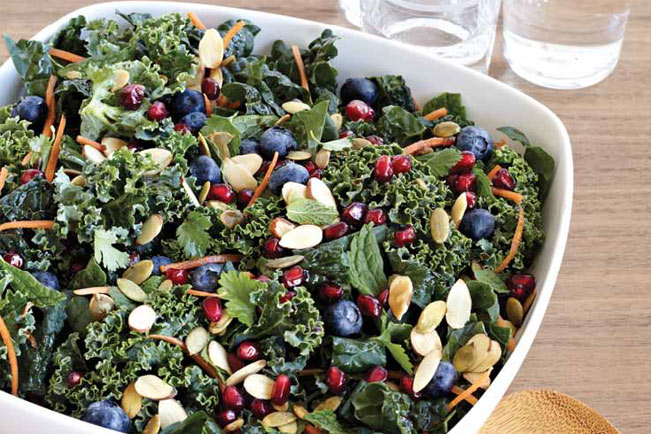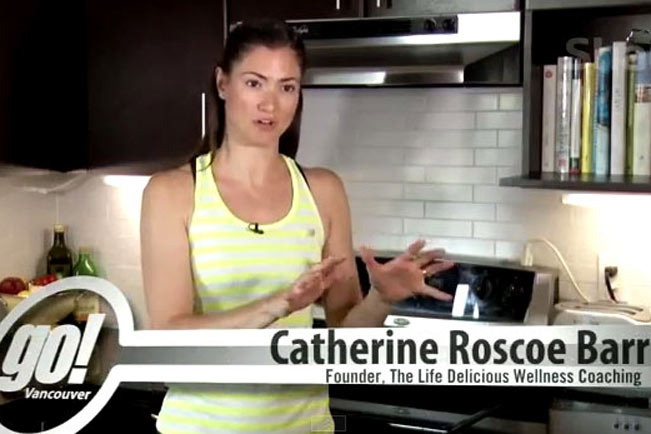 (Image: BC Blueberry Council)
(Image: BC Blueberry Council)
Last week I had the pleasure of attending a breakfast lecture, hosted by the BC Blueberry Council at the Edible Canada Bistro, with author, speaker, geriatric neurologist and dementia specialist, and director of the Banner Sun Health Research Institute, Dr Marwan Sabbagh.
Sabbagh’s talk focused on how dietary habits influence the risk of neurodegenerative diseases, like Alzheimer’s, and how blueberries fit into that equation.
We also received a copy of his awesome new book, The Alzheimer’s Prevention Cookbook: Recipes to Boost Brain Health, which covers the science of Alzheimer’s disease, highlights of which we learned in his talk, and contains brain-boosting recipes that he teamed up with celebrity chef Beau MacMillan to create.

Dr Marwan Sabbagh, left, and I with his new book, The Alzheimer’s Prevention Cookbook: Recipes to Boost Brain Health, at the Edible Canada Bistro. (Image: Catherine Roscoe Barr)
The lecture was one of those instances where I was so engaged with what I was hearing that space and time fell away.
You may or may not know that I have a neuroscience degree and that I am passionate about learning and sharing ways to cultivate optimal brain health, so what he had to say really got me excited.
Sabbagh shared a number of things that I already knew but were great to be reminded of and I also took away a handful of exciting and practical new tips for following a healthy brain diet.
Neurodegeneration Begins 25 Years Before Symptoms Appear
One thing he said really struck me. It’s compelled me to put even more thought and care into what I eat. Changes in the brain – negative changes associated with neurodegeneration – begin to occur 25 years before a clinical diagnosis is possible.
In other words, the disease starts 25 years before the first symptoms are detected.
That means there’s plenty you can do right now, through nutrition, exercise and stress management, to increase your chances of having a sharp mind till the day you drop! That, in addition to keeping a long list of nasties like heart disease, osteoporosis, and rheumatoid arthritis at bay.
The Mediterranean Diet is the Convergence of All Good Things
The quickest and most efficient way to influence change, says Sabbagh, is through diet, and he strongly suggests adopting the Mediterranean Diet, calling it “the convergence of all good things.”
The diet includes very little foods high in saturated fats and cholesterol, with a focus on consuming dark vegetables (like alfalfa, beets, bell peppers, broccoli, Brussels sprouts, corn, eggplant, kale and spinach), high-antioxidant fruits (like blackberries, blueberries, cherries, oranges, plums, prunes, raspberries, strawberries and red grapes), and fish high in Omega-3 fatty acids (like halibut, mackerel, salmon, trout and tuna). It even allows for a moderate amount of red wine!
Hooray, Red Wine is Good for You!
Red wine contains Resveratrol, a compound that’s “been shown to have anti-cancer, antiviral, neuroprotective, anti-aging, anti-inflammatory, and life-prolonging effects.”
So, is more better? Unfortunately, says Sabbagh, you’d need to drink about six bottles of red wine per day to get the optimal recommended amount of Resveratrol. Your liver would not approve.
Sabbagh’s recommendation: stick to a maximum of two glasses of red wine per day and take a Resveratrol supplement.
Herbs and Spices are Antioxidant Powerhouses
Sabbagh also suggests eating foods with high ORAC, or Oxygen Radical Absorbance Capacity, scores. He says, “USDA researchers estimate that you can derive great benefits from consuming 3,000 to 5,000 ORAC units of antioxidants a day.”
I’d never heard of ORAC scores before. Exciting! Following is a list of high-antioxidant herbs, spices, fruits and vegetables, and their ORAC scores, recommended by Sabbagh.
Herbs and Spices (roughly 2 to 4 grams per tsp)
- Cloves, ground – 290,283 ORAC units per 100 grams
- Oregano, dried – 175,295 ORAC units 100 grams
- Rosemary, dried – 165,280 ORAC units per 100 grams
- Thyme, dried – 157,380 ORAC units per 100 grams
- Cinnamon, ground – 131,420 ORAC units per 100 grams
- Turmeric, ground – 127,068 ORAC units per 100 grams
Fruits
- Prunes – 5,770 ORAC units per 100 grams
- Raisins – 2,830 ORAC units per 100 grams
- Blueberries – 2,400 ORAC units per 100 grams
- Blackberries – 2,036 ORAC units per 100 grams
- Strawberries – 1,540 ORAC units per 100 grams
- Raspberries – 1,220 ORAC units per 100 grams
Vegetables
- Kale – 1,770 ORAC units per 100 grams
- Spinach – 1,260 ORAC units per 100 grams
- Brussels sprouts – 980 ORAC units per 100 grams
- Alfalfa sprouts – 930 ORAC units per 100 grams
- Broccoli florets – 890 ORAC units per 100 grams
- Beets – 840 ORAC units per 100 grams
Fun fact: Sabbagh says that since learning about cinnamon’s high ORAC score, and a study “revealing that cinnamon has direct anti-Alzheimer’s properties," he has a teaspoon in his coffee every day.
Blueberries’ Brain-Boosting Power
Zeroing in on blueberries, Sabbagh says that the science behind the brain-boosting power of blueberries – not just berries with high a ORAC score – is “quite compelling.”
Part of his excitement about blueberries stems from animal studies of blueberry extract which show that it can reverse age-related cognitive and motor deficit, prevent free radical damage in red blood cells, and enhance memory-associated neuronal signaling.
He also calls blueberries a “medical-type food” due to another animal-based study showing their ability to “cross the blood-brain barrier and localize in various brain regions important for learning and memory.”
Many drugs are unable to cross the blood-brain barrier, so this was a particularly noteworthy discovery.
Essentially, the antioxidant-rich blueberry extract was able to not just prevent memory loss, but reverse neurodegeneration.
Suddenly craving blueberries? Just wait till you see the delicious recipes below!
Actions Steps for a Healthy Brain Diet
But first, I want to share some actions steps for a healthy brain that Sabbagh left us with:
- Adhere to the Mediterranean Diet
- Decrease intake of saturated fat
- Increase intake of anti-oxidant spices
- Eat BC blueberries
- Increase exercise
As well as his favourite brain-boosting supplements:
- Resveratrol
- Vitamins B-9 (folic acid) and B-12
- DHA Omega-3 fatty acids
Smoothie and a Salad: Two Tasty Recipes for a Healthy Brain
The first recipe – which I just whipped up in my blender and am drinking while I write this – was developed by the wonderful staff at the Edible Canada Bistro and served at Sabbagh’s breakfast lecture, while the second one comes from The Alzheimer’s Prevention Cookbook, which is full of fantastic recipes.
Green Zinger Smoothie

(Image: Catherine Roscoe Barr)
Serves 4
Ingredients
- 2 cups spinach
- 5 stalks kale
- 1 cup beets
- 2 tsp fresh ginger
- 2 1/2 cups blueberries
- 1/2 cup lemon juice
- 3 tbsp honey
- 1 1/2 cups green tea
- 1/2 cup water
Instructions
- Add all ingredients to blender and blend until smooth.
Kale, Blueberry and Pomegranate Salad

(Image: Ten Speed Press)
Serves 4
Ingredients
- 3 bunches kale, stemmed and chopped
- 1 cup fresh blueberries
- 2 medium carrots, peeled and shredded
- 1/2 cup pomegranate seeds
- 1/3 cup pumpkin seeds
- 1/3 cup almonds, sliced and toasted
- 1 tbsp fresh mint leaves, chopped
- 1/2 cup soy-sesame vinaigrette (recipe below)
- Salt and freshly ground black pepper
Instructions
- Combine the kale, blueberries, carrots, pomegranate seeds, pumpkin seeds, almonds, and mint in a medium bowl and toss well.
- Drizzle with the vinaigrette and toss again.
- Season to taste with salt and pepper and serve right away.
Soy-Sesame Vinaigrette
Makes 2 cups
Ingredients
- 2 tbsp fresh ginger, peeled and chopped
- 2 tbsp garlic, chopped
- Pinch of red pepper flakes
- 1/4 cup toasted sesame oil
- 1/4 cup peanut oil
- 1/2 cup rice vinegar
- 1/2 cup mirin
- 1/2 cup soy sauce
- 1/2 cup sugar
- 2 tbsp cornstarch
- 2 tbsp water
Instructions
- Combine the ginger, garlic, red pepper flakes, sesame oil, and peanut oil in a blender and puree until creamy.
- Pour the mixture into a medium sauté pan and cook, stirring, over low heat until aromatic and golden in colour, about 6 minutes.
- Add the vinegar, mirin, soy sauce, and sugar to the sauté pan.
- In a small bowl, combine the cornstarch and water, and then stir the cornstarch slurry into the content of the pan.
- Set the pan over low heat and bring the mixture to a boil to thicken, stirring to dissolve the sugar, about 2 minutes.
- Transfer the dressing to a bowl and let cool.
- Cover and refrigerate for up to 1 week.






